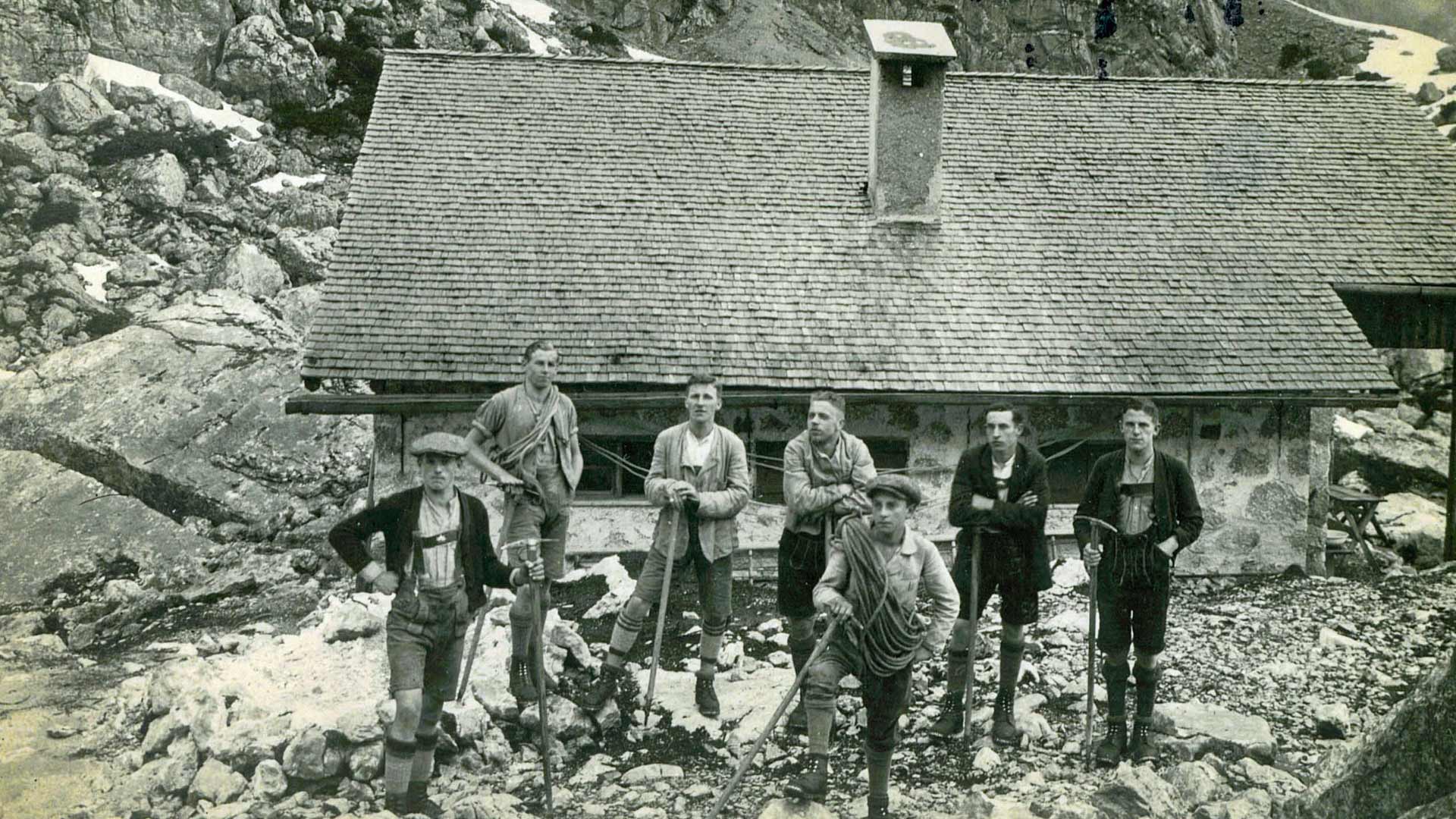If you have any questions, please contact us.
Blaueishütte - DAV Berchtesgaden
Familie Hang
Im Tal 106
83486 Ramsau
info@blaueishuette.de
+49 8657 / 271
(May until October)

While many mountain peaks around the Hochkalter massif were already climbed for the first time around the turn of the century from the 18th to the 19th century, it took a relatively long time until the summit of the Hochkalter could be conquered for the first time.
1830 First ascent of the Hockalter peak by the Salzburg bishop Prince Schwarzenberg
1874 Ascent of the Hockalter via the Blaueis glacier by Salzburg Professor Richter and his guide Kederbach from Ramsau
1886 First ascent of the Blaueisspitze by L. Purtscheller from the Wimbach Valley
24.08.1908 Landslide from the Hockalter peak, which at that time was about 50 to 100 m higher than today. A huge lime block of about 100 m height, 80 x 30 m width, i.e. about 250 000 cubic meters of rock broke off as a whole piece from the summit. A chronicler reports about the landslide:
The mighty landslide occurred on a beautiful summer day and was heard far and wide, felt in Ramsau as an earthquake-like tremor. It had such an effect that a cloud of dust, eclipsing the sun, rose from the summit and descended on a group of mountaineers just beyond the Blaueisscharte, covering their clothes and hats with a thick layer of dust. Another climber, who experienced the landslide from the Watzmann-Hocheck, had the impression that the Hochkalter had exploded.
1919 Ascent of the Schärtenspitze north face by Hans Feichtner
1929 Small-scale northeast pillar by M. Krüttner and K. Weber.
08.Oktober 1922 Opening of a self-catering hut by the Hochland Alpine Club Section at a location about 100m higher than the current Blaueishütte; capacity about 30 camps
Ab 1928 Raphael Hang I manages the hut; the house is already at that time often fully booked on weekends, although the accommodation price is relatively high. A very narrow path leads to the hut, where the food is carried up with a "Kraxn". The glacier still has three steps and wide crevasses at the edges. After the construction of the hut, the area experiences a real rush of visitors. The fact that the location for the house was not optimally chosen became apparent as early as 1923 when an avalanche damaged the roof and windows of the house.
1937 The hut is extended for the first time and a military hut is built near the present Blaueishütte.
1938 With the help of the Wehrmacht, the path to the huts is extended so that mules can also carry luggage and food to the top.
In order to cope with the rush of visitors after the end of the war, the "Hochland" section plans to take over the much more spacious Wehrmacht hut on the Blaueis, which is close to the current hut site.
1946 the Wehrmacht hut burns down to the ground - arson.
1552-53 the "Hochländer" expanded their accommodation house once again, the hut can now accommodate 60 climbers.
29. Dezember 1955 Hermann Buhl from Ramsau reports that the Blaueishütte has been completely destroyed by a dust avalanche.
1956 the "Hochland" section builds an emergency hut in the area of today's Blaueishütte with about 20 sleeping places.
After the construction of a new hut by the Hochland Section fails due to the necessary capital, the Berchtesgaden Section takes over the Blaueis area.
14.09.1958 The Berchtesgaden Section begins construction of today's Blaueishütte, supported by helicopters that transported materials and many volunteers who lend a helping hand.
Am 28. Juli 1962 the new, current Blaueishütte receives the blessing of Julius Cardinal Döpfner, Bishop of Munich and Freising, tenant remained Raphael Hang I. The hut now offers 60 overnight places.
1976 Raphael Hang I hands over the management of the hut to his son Raphael II and his wife Brigitte.
1994 the small transition hut is renovated and expanded to night camps. It also offers overnight accommodation for 24 climbers.
2010 The grandson of the first owner of the hut, Raphael III, takes over the management of the hut together with his wife Regina.
2011/12 The Berchtesgaden Section modernizes the hut. After a long planning phase and the evaluation of several expert opinions, it is decided to solve the disposal of the hut in the future by a wastewater - drainage into the valley. In this course the hut is also connected to the public power supply. The construction work was carried out under strict environmental conditions and with an ecological construction management on site. An extension to the hut is being built using a wooden post and beam construction method. In this extension, a long-awaited drying room is realized, new extended sanitary facilities are accommodated and a kitchen extension is carried out. In front of the hut, a new panoramic wooden terrace is being built. Underneath there are storage tanks for rainwater for the operation of the toilet flushing.
2013 The Blaueishütte is awarded with the environmental seal of the alpine associations.
2015/16 In order to comply with the current fire protection regulations, further extensive conversion measures are being carried out. The three large mattress dormitories on the top floor are being converted and small four-bed room units with bunk beds are being created around a fire-safe escape corridor. 32 guests can now still be accommodated in the attic.
This is how our guests rate us